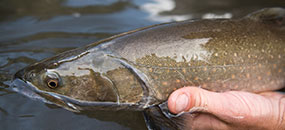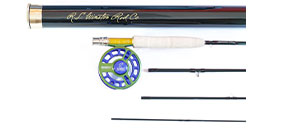Trout Unlimited staff and partners braved snow and cold to finish a fish passage project on Hinton Creek in Michigan.
By Jeremy Geist
Headwater streams are a critical component to the overall health of a watershed and largely add to the biodiversity of a whole river system. These types of streams are the ones we find tucked away in the woods, covered by forest canopy and only fishable with a 3-weight fly rod.
In 2017, Trout Unlimited staff in Michigan had an exceptionally active year working to improve habitat and connectivity in stream systems to help make those streams healthier and more vibrant.
Despite the misleading notion one might get when hopping over a small headwater tributary, collectively these smaller streams often make up the majority of river length in a watershed. Headwater streams provide a variety of ecological services such as flood storage capacity, groundwater recharge and pollutant filtration, and are ultimately responsible for providing energy supplies (i.e., wood and organic matter) to downstream river segments.
Small tributaries also provide important habitat for invertebrates such as stoneflies and caddisflies, brook trout, smaller age classes of other trout and salmon species, as well as other non-game cold-water fishes (e.g., sculpin). Disturbances to these streams can have far reaching consequences to the overall integrity of a river system so it is imperative that we restore, reconnect and protect headwater streams to maintain water quality and biological diversity in our watersheds.
TU accomplished impressive things in Michigan this past field season. All in all, TU restored and reconnected over 31 miles of cold-water streams through four wood addition projects, one small dam and pond removal, and five road culvert improvement projects.
Many of these projects took place in headwater streams in Northwest Michigan (Lower Peninsula), within and around the Huron-Manistee National Forest, and will provide great benefits to native and wild populations of trout. TU chapter volunteers assisted with native tree and shrub restoration at the project sites, installing more than 1,0000 native plants in riparian areas.
The Michigan State Council TU and local TU chapter volunteers conducted habitat surveys and temperature monitoring in the Pere Marquette River at more than 12 locations to help prioritize future restoration efforts. To evaluate ongoing restoration projects, and to prepare for upcoming field seasons, TU staff and field technicians conducted ground surveys at 10 road/stream crossing project sites and completed biological surveys (fish and invertebrates) at eight sites.
The 2017 field season lasted unexpectedly long, stretching the construction time-frame unusually late into the year. Fall conditions were unseasonably mild so trying to fit in one more project before year end seemed reasonable.
The Hinton Creek culvert project site, before and after.
As luck would have it; however, the weather turned just as construction commenced on our last road-stream crossing improvement project for the year! Hinton Creek, a small headwater stream to the Big Manistee River, squeezed beneath two roads through undersized culverts, which were set to be improved during the 2017 field season.
Construction had been set back later in the year due to a delay in material availability, so TU staff and project partners stood through a cold and snowy two-week period in December to complete the project.
Snow accumulations adding up to double digits and dropping temperatures made for a “memorable experience” to say the least for TU staff and partners. In the end, the project was completed, and as a result, 5 miles of high-quality habitat in Hinton Creek was reconnected for brook trout and other organisms.
TU’s efforts to improve trout streams in Michigan could not be done without help from funding sources such as National Fish and Wildlife Foundation – Sustain our Great Lakes, Great Lakes Fishery Trust, Michigan Department of Natural Resources – Aquatic Habitat Grant, USDA Forest Service – Huron-Manistee National Forest Great Lakes Restoration Initiative, CMLG and Stewardship funds, USDA Forest Service Eastern Region, Healing Our Waters – Freshwater Future, Federation of Flyfishers International, U.S. Fish and Wildlife National Fish Passage Program, National Resources Conservation Service Regional Conservation Partnership Program, local TU Chapters and area partner donations. Other partners include Wexford County, Kalkaska County, Newaygo County and Lake County Road Commissions as well as Conservation Resource Alliance.
Jeremy Geist is the Trout Unlimited's Great Lakes stream restoration manager, and is based in Michigan.




